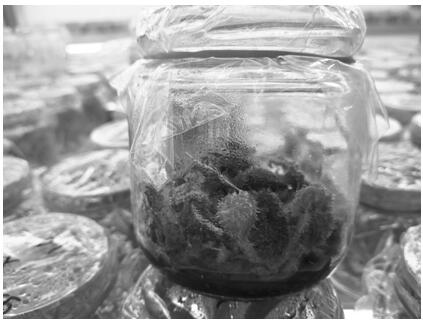A method for reducing the browning rate of leaf tissue culture of Begonia variegata
A technology for tissue culture and begonia, applied in the field of plant tissue culture, can solve the problems of limiting the tissue culture efficiency and browning of begonia variegata, and achieve the effects of reducing pollution rate and browning rate, eliminating browning, and increasing induction rate
- Summary
- Abstract
- Description
- Claims
- Application Information
AI Technical Summary
Problems solved by technology
Method used
Image
Examples
Embodiment 1
[0025] A method for reducing the browning rate of begonia iridescent leaf tissue culture, comprising the steps of:
[0026] Step (1), refrigerated preservation treatment: refrigerated fresh young leaves of Begonia variegata in a refrigerator at 4°C for 1 day;
[0027] Step (2), disinfection and treatment of explants: After washing the young leaves treated in step (1) with washing powder water, soak them in alcohol with a volume concentration of 75% for 30 seconds, and then wash them with 0.1% HgCl 2 The solution was treated for 5 minutes, followed by rinsing with sterile water for 3 times; then under aseptic conditions, the water was absorbed with sterile filter paper, and then the leaves were cut into 2cm 2 size leaf disk;
[0028] Step (3), dark culture: scratch the back of the leaf disc obtained in step (2), inoculate the primary culture medium with the back of the leaves facing down, and culture in the dark for 5 days at a culture temperature of 23±2°C;
[0029] Step (4)...
Embodiment 2
[0034] A method for reducing the browning rate of begonia iridescent leaf tissue culture, comprising the steps of:
[0035] Step (1), refrigerated preservation treatment: refrigerated fresh young leaves of Begonia variegata in a refrigerator at 4°C for 2 days;
[0036] Step (2), disinfection and treatment of explants: After washing the young leaves treated in step (1) with washing powder water, soak them in alcohol with a volume concentration of 75% for 30 seconds, and then wash them with 0.1% HgCl 2 The solution was treated for 8 minutes, and then rinsed with sterile water for 3 times, each time for 2 minutes; then under sterile conditions, use sterile filter paper to absorb water, and then cut the leaves into 2cm 2 size leaf disk;
[0037] Step (3), dark culture: scratch the back of the leaf disc obtained in step (2), inoculate the primary culture medium with the back of the leaves facing down, and culture in the dark for 5 days at a culture temperature of 23±2°C;
[0038]...
Embodiment 3
[0043] A method for reducing the browning rate of begonia iridescent leaf tissue culture, comprising the steps of:
[0044] Step (1), refrigerated preservation treatment: refrigerated fresh young leaves of Begonia variegata in a refrigerator at 4°C for 1 day;
[0045] Step (2), disinfection and treatment of explants: After washing the young leaves treated in step (1) with washing powder water, soak them in alcohol with a volume concentration of 70% for 20 seconds, and then wash them with 0.1% HgCl 2 The solution was treated for 5 minutes, then rinsed with sterile water for 3 times, each time for 2 minutes; then under sterile conditions, use sterile filter paper to absorb water, and then cut the leaves into 1.8cm 2 size leaf disk;
[0046] Step (3), dark culture: scratch the back of the leaf disc obtained in step (2), inoculate the primary culture medium with the back of the leaves facing down, and culture in the dark for 5 days at a culture temperature of 23±2°C;
[0047] St...
PUM
 Login to View More
Login to View More Abstract
Description
Claims
Application Information
 Login to View More
Login to View More - R&D
- Intellectual Property
- Life Sciences
- Materials
- Tech Scout
- Unparalleled Data Quality
- Higher Quality Content
- 60% Fewer Hallucinations
Browse by: Latest US Patents, China's latest patents, Technical Efficacy Thesaurus, Application Domain, Technology Topic, Popular Technical Reports.
© 2025 PatSnap. All rights reserved.Legal|Privacy policy|Modern Slavery Act Transparency Statement|Sitemap|About US| Contact US: help@patsnap.com



